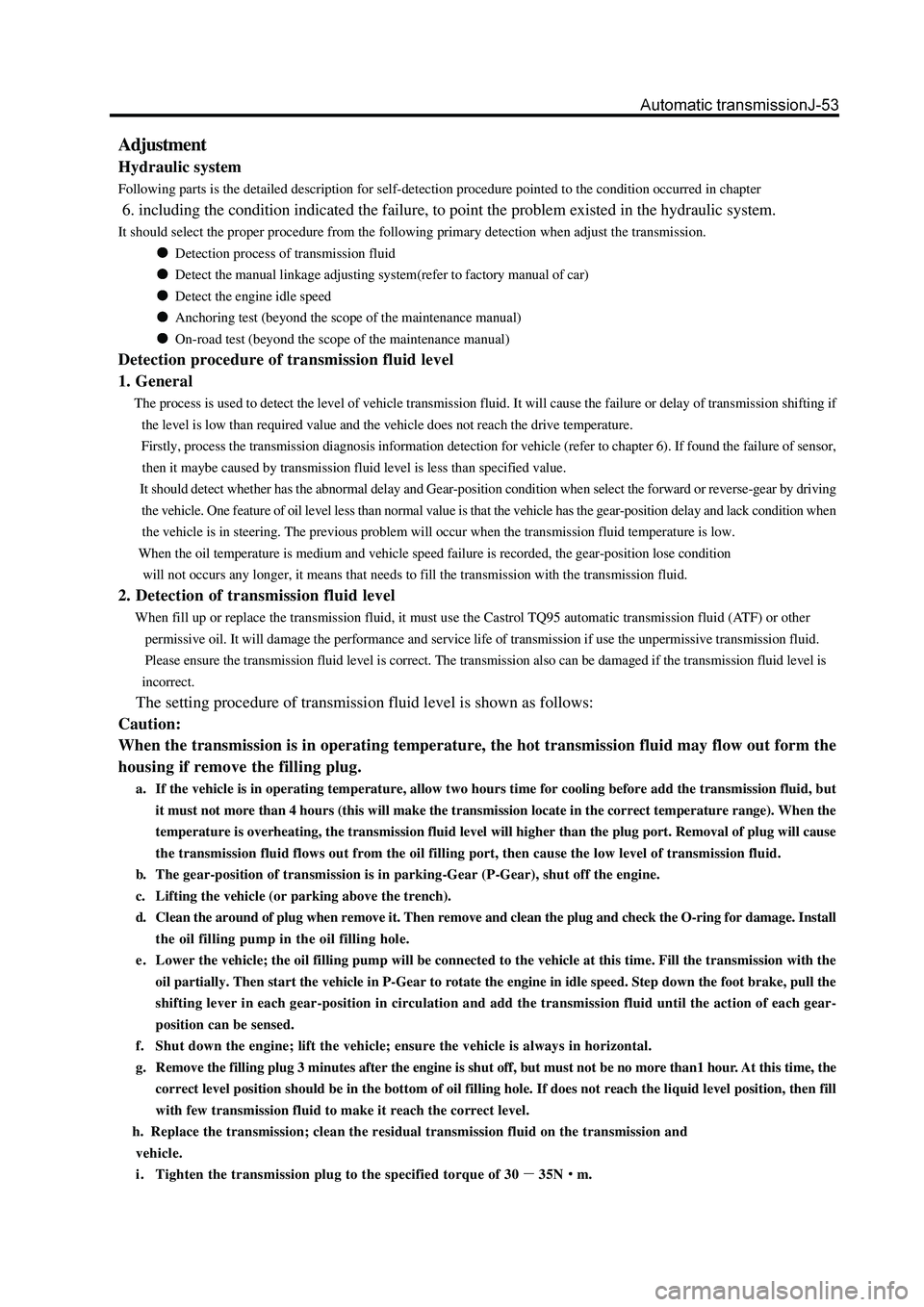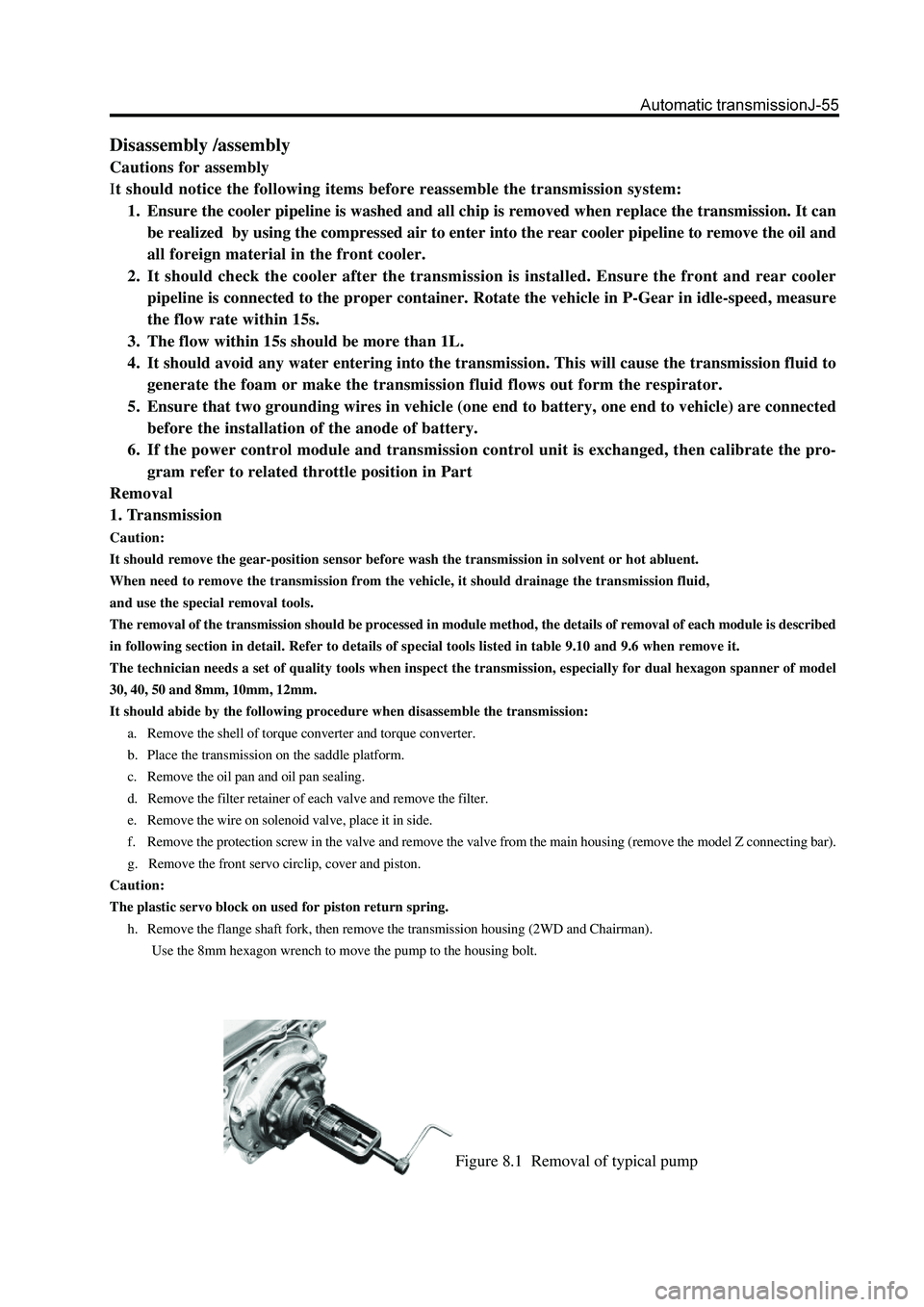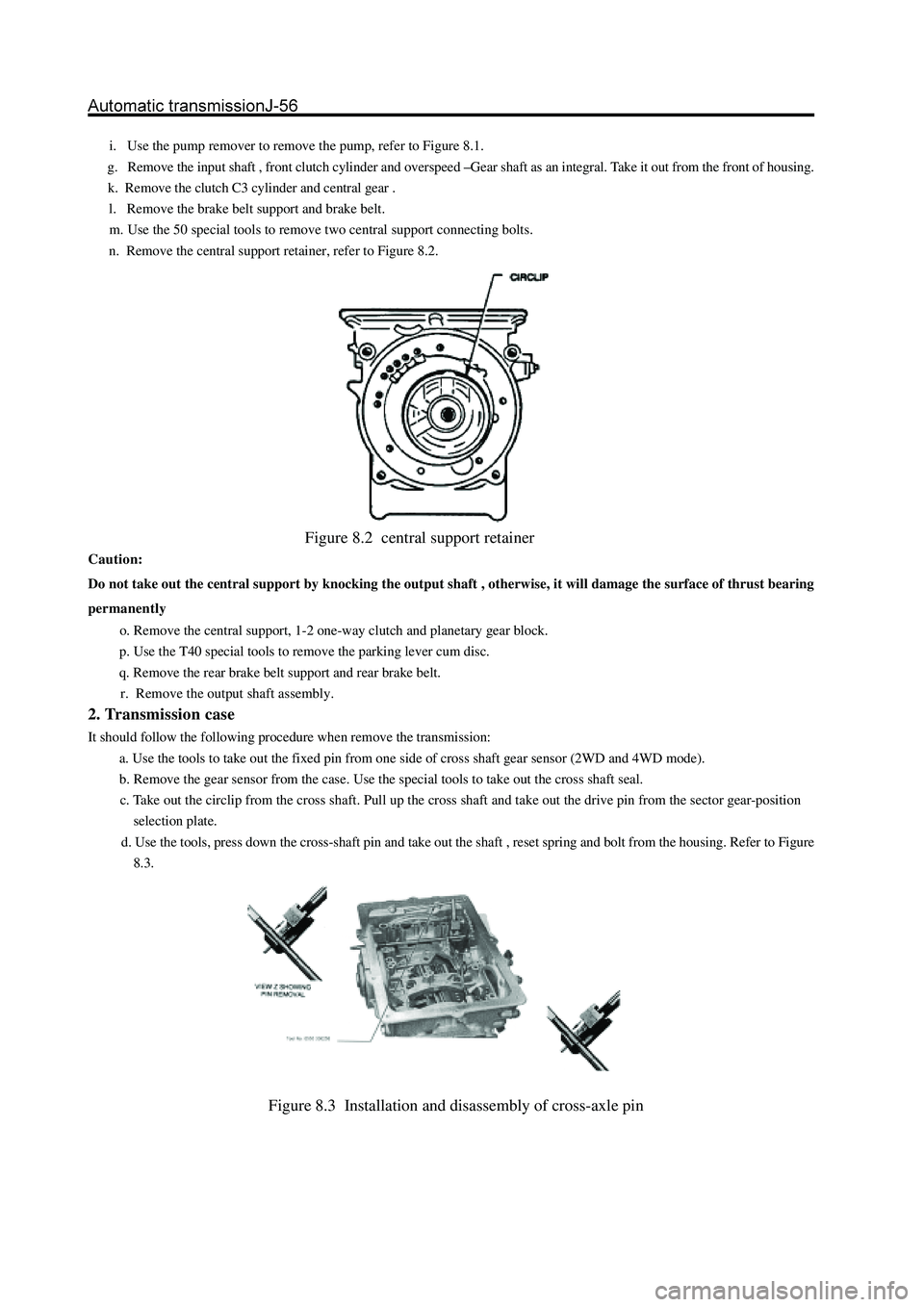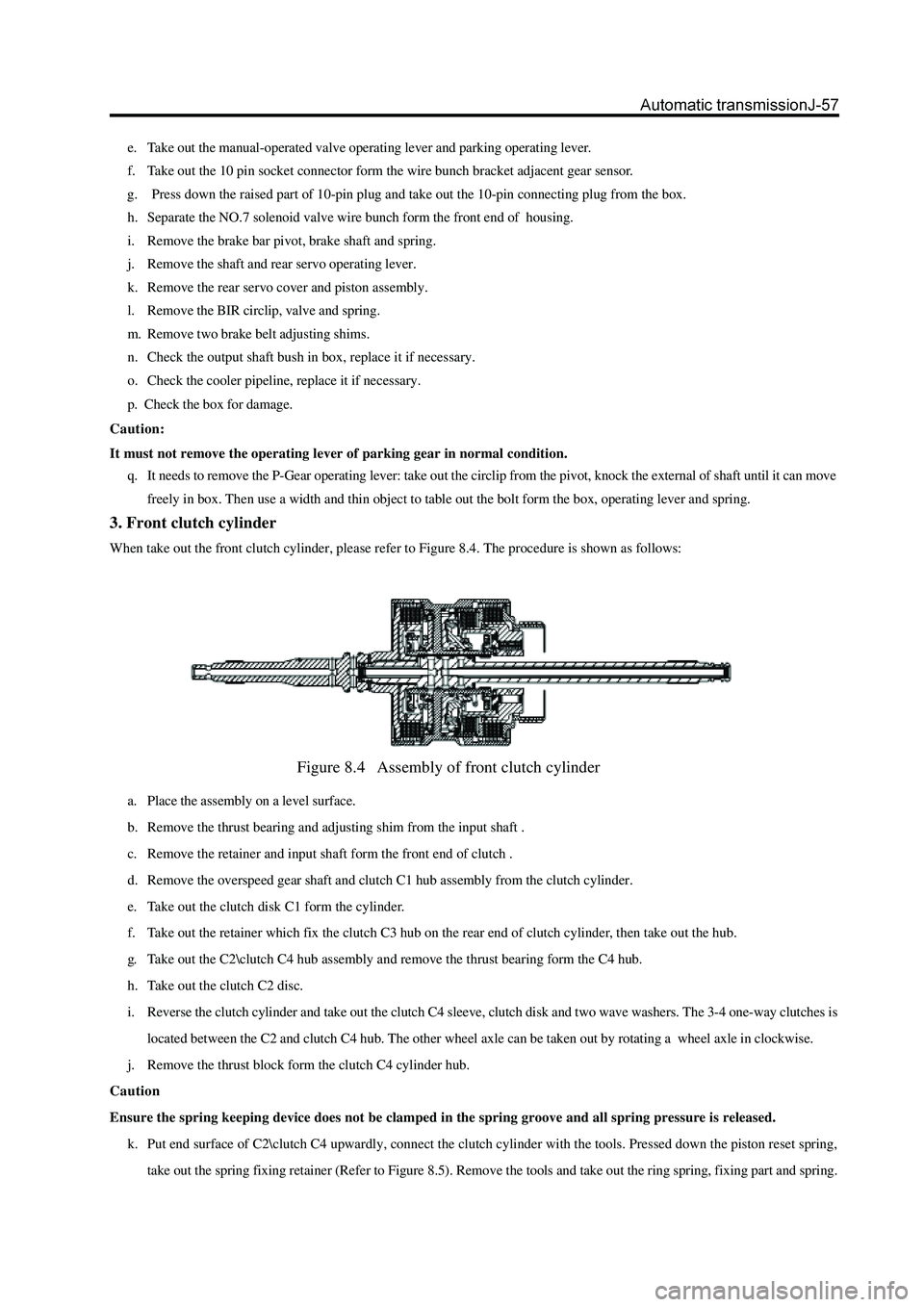2006 GREAT WALL HOVER sensor
[x] Cancel search: sensorPage 123 of 425

Automatic transmission-47
4. Operating mode of transmission
TCU realizes the effective control for the transmission according to the accurate information acquired form the input data and
complete control for the output data. To ensure the input and output of TCU is actual and effective, TCU executes the data sense
command for hardware and software. For the failure information found in the following operating mode described in detail, TCU
will give the corresponding response.
Similarly, it exists the possibility that could not find out the failure cause. If encounter the condition, the operation for transmis
sion is determined difficultly.
Following condition will effect the operation of transmission, but will not appear the detection failure information.
a. Power supply failure
The transmission adopts the 3-Gear lame Home Mode (LHM) irrelevant to car speed.
If occur the intermittent power supply, then TCU will start form 4-Gear and is switched to the proper gear to meet the
requirement of current work. At this time, it will not monitor the power supply status.
b. The transmission fluid temperature is higher than 135
If found the transmission temperature is high:
The torque converter lock clutch will start in low speed and the car will have the vibration.
Some cars will have the condition that the mode indicator lamp is flash.
The reason for the condition may be the transmission fluid temperature is high or acquire the inaccurate single form the
temperature sensor. If occurs the temperature failure, it may find the high temperature operating condition.
c. Failure of ON/OFF solenoid valve
If one of the solenoid valves has the mechanical failure, TCU will not find the failure. At this time, the failure operation of
transmission will be determined according to the solenoid valve with failure. The characteristic of different solenoid valve failure
is listed in Table 6.1.2.
reverse pin
gear indication pin
Gear sensor(black)
Figure 6.1.1 Description for wire bundle pin
Page 126 of 425

Automatic transmission-50
Only can 1→3→4
shifting The sm all O -ring of front servo piston is invalid or lost.
2→3 G ear psition shifting valve is blocked. D etect the O -ring. P rocess the replacem ent or
reinstallatio n if n ecessary. D etect th e 2→3
G ear shifting valve; Process the maintenance
or replacem ent according to the requirem ent.
Only can 1→2→1
shifting C1 is invalid or 3rd-G ear and 4th- G ea r is lo o s e . (g iv e t o
1st-G ear in 3rd-gear; give to 2nd-G ear in 4th-G ear) D etect th e clutch C 1 . R ep air or rep la ce it if
necessary.
Can not realize the
manual 4→3, 3→2, 2
→1 O verspeed clutch /ball spool has displacem ent.
C4 is invalid. D etect the ball spool. Process the replacem ent
or reinstallation according to the req uirem ent.
D etect the C4. R epair C4 or replace the C 4
wave pan according to the necessary.
W itho ut m an ual
1st-G ear The rear brake belt is loose when the tem perature is
high.
The R -G ear/Low speed 1
st-G ear ball spool has
displacem ent.
The internal “O ” –ring of rear servo is lost.
C4 is invalid. D etect the rear brake b elt, adjust id necessary.
D et e ct t h e b a ll sp o o l, R ein s ta ll o r r ep la c e it if
necessary.
D etect the O -ring, R einstall or replace it if
necessary.
D et e ct th e C 4 . R ep a ir o r r ep la c e it if n e c ess a r y.
Only can 1→2→2→4
gear. The dim ension of socket of front servo is large. H as the
possibility of loose of plug.
It has the trend that ca n n ot realize th e reverse-G ear if
drive the vehicle in this condition continuously. Repair or replace it if necessary.
Detect the C3 piston O -ring, replace it if
necessary.
Only an 1st-gear,
2nd-G ear, 4th-G ear or
1st-G ear, 2nd-G ear an d
3rd-G ear.(3rd-G ear is
tightened) The gear sensor has failure, only can1→2→3 shifting.
3→4 Gear shifting valve is blocked. D etect the gear-position sensor. R epair or
replace it if necessary. D etect the 3→4 gear
shiftin g va lv e. R ep air or r ep la ce it if
necessary.
Page 127 of 425

Automatic transmission-51
Table 6.2.3Shifting quality failure
Bad 1→2 Gear
shifting quality The throttle position sensor has failure.
T he brake b elt is adjusted incorrectly.
The front servo piston O-ring is damaged.
The variable pressure solenoid valve (S5) is damaged or
has failure.
S1, S4 has the failure.
The brake belt combination regulating valve (BAR) has
the failur e.
The front servo release spring is installed incorrectly. Detect the resistance, replace the sensor if
necessary.
Detect and replace the rake belt if necessary.
Detect and r epla ce the O -ring if necessary.
Detect, repair or repla ce the S5 if necessary.
Detect, repair or repla ce the S1, S4 if
necessary.
Detect, repair or repla ce the B AR if
necessary.
Detect and repair it if necessary.
Bad 2→3 Gear
shifting quality B1brake belt release valve is blocked.
S3, S2 has the failure.
The clutch combination regulating valve has failure.
The clutch combination oil feed ball spool is lost or
damaged.
The input shaft oil seal is damaged.
C1 piston O-ring is damaged.
C1 piston oil feed ball spool is damaged. Detect the blow-off valve. Replace or
maintain it if necessary.
Detect the S3, S2.Replace or maintain it if
necessary.
Detect the r egulating valve. R eplace or
maintain it if necessary.
Detect the ball spool .Reinstall or replace it if
necessary.
Detect the sealing ring. Reinstall or replace it
if necessary.
Detect the O -ring .R einstall or replace it if
necessary.
Detect the ball spool .Reinstall or replace it if
necessary.
Bad 3→4 Gear
shifting quality S1, S4 has failure.
B1brake belt release valve is blocked.
T he brake b elt is adjusted incorrectly.
The front servo piston O-ring is damaged.
The variable pressure solenoid valve (S5) is damaged or
has failure.
The brake belt combination regulating valve has failure. Detect the S1, S4.R einstall or replace it if
necessary.
Detect the blow-off valve. Replace or repair
it if necessary.
Detect the brake belt. Adjust it if necessary.
Detect the O -ring .R eplace or maintain it if
necessary.
Detect the S5.R epla ce or maintain it if
necessary.
Detect the r egulating valve. R eplace or
maintain it if necessary.
The engine has
the
extinguishing
co nd itio n
when select
the automatic
gear or R-gear. The torque converter clutch control valve is blocked or
solenoid valve 7 has failure. Detect and clean the torque converter clutch
valve (CCCV)
Has unstable
vibration
co nd itio n. S7 has the failure. Process the necessary detection, maintenance
and replacement according to the
requirem ent.
Page 129 of 425

Adjustment
Hydraulic system
Following parts is the detailed description for self-detection procedure pointed to the condition occurred in chapter
6. including the condition indicated the failure, to point the problem existed in the hydraulic system.
It should select the proper procedure from the following primary detection when adjust the transmission.
Detection process of transmission fluid
Detect the manual linkage adjusting system(refer to factory manual of car)
Detect the engine idle speed
Anchoring test (beyond the scope of the maintenance manual)
On-road test (beyond the scope of the maintenance manual)
Detection procedure of transmission fluid level
1. General
The process is used to detect the level of vehicle transmission fluid. It will cause the failure or delay of transmission shifting if
the level is low than required value and the vehicle does not reach the drive temperature.
Firstly, process the transmission diagnosis information detection for vehicle (refer to chapter 6). If found the failure of sensor,
then it maybe caused by transmission fluid level is less than specified value.
It should detect whether has the abnormal delay and Gear-position condition when select the forward or reverse-gear by driving
the vehicle. One feature of oil level less than normal value is that the vehicle has the gear-position delay and lack condition when
the vehicle is in steering. The previous problem will occur when the transmission fluid temperature is low.
When the oil temperature is medium and vehicle speed failure is recorded, the gear-position lose condition
will not occurs any longer, it means that needs to fill the transmission with the transmission fluid.
2. Detection of transmission fluid level
When fill up or replace the transmission fluid, it must use the Castrol TQ95 automatic transmission fluid (ATF) or other
permissive oil. It will damage the performance and service life of transmission if use the unpermissive transmission fluid.
Please ensure the transmission fluid level is correct. The transmission also can be damaged if the transmission fluid level is
incorrect.
The setting procedure of transmission fluid level is shown as follows:
Caution:
When the transmission is in operating temperature, the hot transmission fluid may flow out form the
housing if remove the filling plug.
a. If the vehicle is in operating temperature, allow two hours time for cooling before add the transmission fluid, but
it must not more than 4 hours (this will make the transmission locate in the correct temperature range). When the
temperature is overheating, the transmission fluid level will higher than the plug port. Removal of plug will cause
the transmission fluid flows out from the oil filling port, then cause the low level of transmission fluid.
b. The gear-position of transmission is in parking-Gear (P-Gear), shut off the engine.
c. Lifting the vehicle (or parking above the trench).
d. Clean the around of plug when remove it. Then remove and clean the plug and check the O-ring for damage. Install
the oil filling pump in the oil filling hole.
e. Lower the vehicle; the oil filling pump will be connected to the vehicle at this time. Fill the transmission with the
oil partially. Then start the vehicle in P-Gear to rotate the engine in idle speed. Step down the foot brake, pull the
shifting lever in each gear-position in circulation and add the transmission fluid until the action of each gear-
position can be sensed.
f. Shut down the engine; lift the vehicle; ensure the vehicle is always in horizontal.
g. Remove the filling plug 3 minutes after the engine is shut off, but must not be no more than1 hour. At this time, the
correct level position should be in the bottom of oil filling hole. If does not reach the liquid level position, then fill
with few transmission fluid to make it reach the correct level.
h. Replace the transmission; clean the residual transmission fluid on the transmission and
vehicle.
i. Tighten the transmission plug to the specified torque of 30
35Nm.
Page 131 of 425

Figure 8.1 Removal of typical pump
Disassembly /assembly
Cautions for assembly
It should notice the following items before reassemble the transmission system:
1. Ensure the cooler pipeline is washed and all chip is removed when replace the transmission. It can
be realized by using the compressed air to enter into the rear cooler pipeline to remove the oil and
all foreign material in the front cooler.
2. It should check the cooler after the transmission is installed. Ensure the front and rear cooler
pipeline is connected to the proper container. Rotate the vehicle in P-Gear in idle-speed, measure
the flow rate within 15s.
3. The flow within 15s should be more than 1L.
4. It should avoid any water entering into the transmission. This will cause the transmission fluid to
generate the foam or make the transmission fluid flows out form the respirator.
5. Ensure that two grounding wires in vehicle (one end to battery, one end to vehicle) are connected
before the installation of the anode of battery.
6. If the power control module and transmission control unit is exchanged, then calibrate the pro-
gram refer to related throttle position in Part
Removal
1. Transmission
Caution:
It should remove the gear-position sensor before wash the transmission in solvent or hot abluent.
When need to remove the transmission from the vehicle, it should drainage the transmission fluid,
and use the special removal tools.
The removal of the transmission should be processed in module method, the details of removal of each module is described
in following section in detail. Refer to details of special tools listed in table 9.10 and 9.6 when remove it.
The technician needs a set of quality tools when inspect the transmission, especially for dual hexagon spanner of model
30, 40, 50 and 8mm, 10mm, 12mm.
It should abide by the following procedure when disassemble the transmission:
a. Remove the shell of torque converter and torque converter.
b. Place the transmission on the saddle platform.
c. Remove the oil pan and oil pan sealing.
d. Remove the filter retainer of each valve and remove the filter.
e. Remove the wire on solenoid valve, place it in side.
f. Remove the protection screw in the valve and remove the valve from the main housing (remove the model Z connecting bar).
g. Remove the front servo circlip, cover and piston.
Caution:
The plastic servo block on used for piston return spring.
h. Remove the flange shaft fork, then remove the transmission housing (2WD and Chairman).
Use the 8mm hexagon wrench to move the pump to the housing bolt.
Page 132 of 425

Caution:
Do not take out the central support by knocking the output shaft , otherwise, it will damage the surface of thrust bearing
permanently
o. Remove the central support, 1-2 one-way clutch and planetary gear block.
p. Use the T40 special tools to remove the parking lever cum disc.
q. Remove the rear brake belt support and rear brake belt.
r. Remove the output shaft assembly.
2. Transmission case
It should follow the following procedure when remove the transmission:
a. Use the tools to take out the fixed pin from one side of cross shaft gear sensor (2WD and 4WD mode).
b. Remove the gear sensor from the case. Use the special tools to take out the cross shaft seal.
c. Take out the circlip from the cross shaft. Pull up the cross shaft and take out the drive pin from the sector gear-position
selection plate.
d. Use the tools, press down the cross-shaft pin and take out the shaft , reset spring and bolt from the housing. Refer to Figure
8.3.
Figure 8.3 Installation and disassembly of cross-axle pinFigure 8.2 central support retainer
i. Use the pump remover to remove the pump, refer to Figure 8.1.
g. Remove the input shaft , front clutch cylinder and overspeed –Gear shaft as an integral. Take it out from the front of housing.
k. Remove the clutch C3 cylinder and central gear .
l. Remove the brake belt support and brake belt.
m. Use the 50 special tools to remove two central support connecting bolts.
n. Remove the central support retainer, refer to Figure 8.2.
Page 133 of 425

e. Take out the manual-operated valve operating lever and parking operating lever.
f. Take out the 10 pin socket connector form the wire bunch bracket adjacent gear sensor.
g. Press down the raised part of 10-pin plug and take out the 10-pin connecting plug from the box.
h. Separate the NO.7 solenoid valve wire bunch form the front end of housing.
i. Remove the brake bar pivot, brake shaft and spring.
j. Remove the shaft and rear servo operating lever.
k. Remove the rear servo cover and piston assembly.
l. Remove the BIR circlip, valve and spring.
m. Remove two brake belt adjusting shims.
n. Check the output shaft bush in box, replace it if necessary.
o. Check the cooler pipeline, replace it if necessary.
p. Check the box for damage.
Caution:
It must not remove the operating lever of parking gear in normal condition.
q. It needs to remove the P-Gear operating lever: take out the circlip from the pivot, knock the external of shaft until it can move
freely in box. Then use a width and thin object to table out the bolt form the box, operating lever and spring.
3. Front clutch cylinder
When take out the front clutch cylinder, please refer to Figure 8.4. The procedure is shown as follows:
Figure 8.4 Assembly of front clutch cylinder
a. Place the assembly on a level surface.
b. Remove the thrust bearing and adjusting shim from the input shaft .
c. Remove the retainer and input shaft form the front end of clutch .
d. Remove the overspeed gear shaft and clutch C1 hub assembly from the clutch cylinder.
e. Take out the clutch disk C1 form the cylinder.
f. Take out the retainer which fix the clutch C3 hub on the rear end of clutch cylinder, then take out the hub.
g. Take out the C2\clutch C4 hub assembly and remove the thrust bearing form the C4 hub.
h. Take out the clutch C2 disc.
i. Reverse the clutch cylinder and take out the clutch C4 sleeve, clutch disk and two wave washers. The 3-4 one-way clutches is
located between the C2 and clutch C4 hub. The other wheel axle can be taken out by rotating a wheel axle in clockwise.
j. Remove the thrust block form the clutch C4 cylinder hub.
Caution
Ensure the spring keeping device does not be clamped in the spring groove and all spring pressure is released.
k. Put end surface of C2\clutch C4 upwardly, connect the clutch cylinder with the tools. Pressed down the piston reset spring,
take out the spring fixing retainer (Refer to Figure 8.5). Remove the tools and take out the ring spring, fixing part and spring.
Page 138 of 425

Figure 8.11 Rear servo barCaution:
Pay attention to do not coat the sealant between the bolt and crown bar.
e. Install the parking operating lever (as Figure 8.12), including the return spring and shaft pin. Coat the external end of shaft pin
with small sealant.
f. Use the circlip to protect the shaft pin. Pay attention to ensure the operating lever can rotate around the shaft pin freely and
the spring can make the parking operating lever returns to the correct position.
g. Install the parking brake lever pin and spring. Refer to Figure 8.13.Caution: ensure the rake lever can rotate freely.
h. Connect the parking brake lever to the manual-operated valve connecting rod. Shown as Figure 8.14. Ensure the spring and cam
axle ring are installed on the connecting rod fixedly.
i. Check the cam axle ring for smooth sliding on rod.
j. Install the cross shaft in the box in reverse direction of Gear-position sensor, then install the concussion spring on the shaft.Figure 8.12 Parking operating lever
Figure 8.13 Typical parking brake shaft pin and spring
Figure 8.14 Parking lever and manual shaft